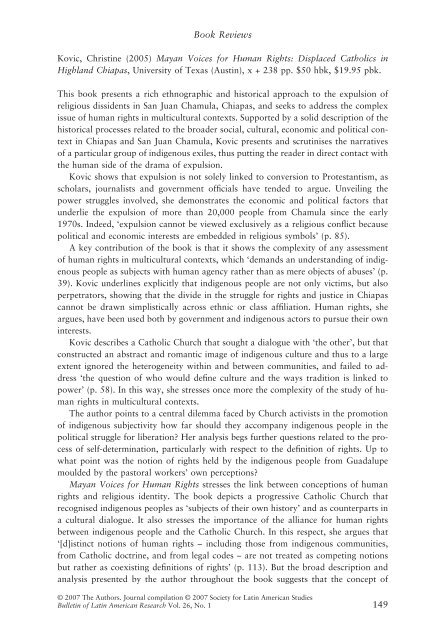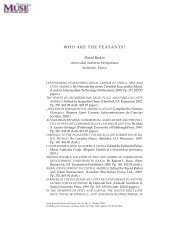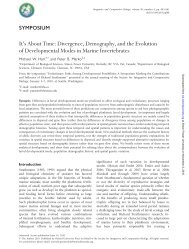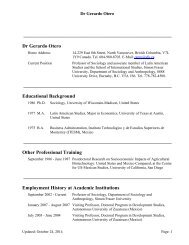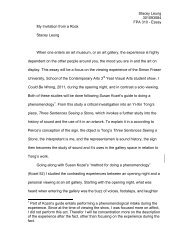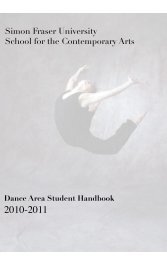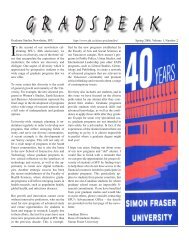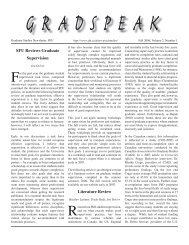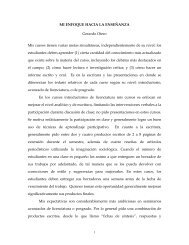Review of Mexico in Transition by Byron Crites
Review of Mexico in Transition by Byron Crites
Review of Mexico in Transition by Byron Crites
- TAGS
- transition
- byron
- crites
- cgi.sfu.ca
You also want an ePaper? Increase the reach of your titles
YUMPU automatically turns print PDFs into web optimized ePapers that Google loves.
Book <strong>Review</strong>s<br />
Kovic, Christ<strong>in</strong>e (2005) Mayan Voices for Human Rights: Displaced Catholics <strong>in</strong><br />
Highland Chiapas , University <strong>of</strong> Texas (Aust<strong>in</strong>), x + 238 pp. $50 hbk, $19.95 pbk.<br />
This book presents a rich ethnographic and historical approach to the expulsion <strong>of</strong><br />
religious dissidents <strong>in</strong> San Juan Chamula, Chiapas, and seeks to address the complex<br />
issue <strong>of</strong> human rights <strong>in</strong> multicultural contexts. Supported <strong>by</strong> a solid description <strong>of</strong> the<br />
historical processes related to the broader social, cultural, economic and political context<br />
<strong>in</strong> Chiapas and San Juan Chamula, Kovic presents and scrut<strong>in</strong>ises the narratives<br />
<strong>of</strong> a particular group <strong>of</strong> <strong>in</strong>digenous exiles, thus putt<strong>in</strong>g the reader <strong>in</strong> direct contact with<br />
the human side <strong>of</strong> the drama <strong>of</strong> expulsion.<br />
Kovic shows that expulsion is not solely l<strong>in</strong>ked to conversion to Protestantism, as<br />
scholars, journalists and government <strong>of</strong>fi cials have tended to argue. Unveil<strong>in</strong>g the<br />
power struggles <strong>in</strong>volved, she demonstrates the economic and political factors that<br />
underlie the expulsion <strong>of</strong> more than 20,000 people from Chamula s<strong>in</strong>ce the early<br />
1970s. Indeed, ‘ expulsion cannot be viewed exclusively as a religious confl ict because<br />
political and economic <strong>in</strong>terests are embedded <strong>in</strong> religious symbols ’ (p. 85).<br />
A key contribution <strong>of</strong> the book is that it shows the complexity <strong>of</strong> any assessment<br />
<strong>of</strong> human rights <strong>in</strong> multicultural contexts, which ‘ demands an understand<strong>in</strong>g <strong>of</strong> <strong>in</strong>digenous<br />
people as subjects with human agency rather than as mere objects <strong>of</strong> abuses ’ (p.<br />
39). Kovic underl<strong>in</strong>es explicitly that <strong>in</strong>digenous people are not only victims, but also<br />
perpetrators, show<strong>in</strong>g that the divide <strong>in</strong> the struggle for rights and justice <strong>in</strong> Chiapas<br />
cannot be drawn simplistically across ethnic or class affi liation. Human rights, she<br />
argues, have been used both <strong>by</strong> government and <strong>in</strong>digenous actors to pursue their own<br />
<strong>in</strong>terests.<br />
Kovic describes a Catholic Church that sought a dialogue with ‘ the other ’ , but that<br />
constructed an abstract and romantic image <strong>of</strong> <strong>in</strong>digenous culture and thus to a large<br />
extent ignored the heterogeneity with<strong>in</strong> and between communities, and failed to address<br />
‘ the question <strong>of</strong> who would defi ne culture and the ways tradition is l<strong>in</strong>ked to<br />
power ’ (p. 58). In this way, she stresses once more the complexity <strong>of</strong> the study <strong>of</strong> human<br />
rights <strong>in</strong> multicultural contexts.<br />
The author po<strong>in</strong>ts to a central dilemma faced <strong>by</strong> Church activists <strong>in</strong> the promotion<br />
<strong>of</strong> <strong>in</strong>digenous subjectivity how far should they accompany <strong>in</strong>digenous people <strong>in</strong> the<br />
political struggle for liberation? Her analysis begs further questions related to the process<br />
<strong>of</strong> self-determ<strong>in</strong>ation, particularly with respect to the defi nition <strong>of</strong> rights. Up to<br />
what po<strong>in</strong>t was the notion <strong>of</strong> rights held <strong>by</strong> the <strong>in</strong>digenous people from Guadalupe<br />
moulded <strong>by</strong> the pastoral workers ’ own perceptions?<br />
Mayan Voices for Human Rights stresses the l<strong>in</strong>k between conceptions <strong>of</strong> human<br />
rights and religious identity. The book depicts a progressive Catholic Church that<br />
recognised <strong>in</strong>digenous peoples as ‘ subjects <strong>of</strong> their own history ’ and as counterparts <strong>in</strong><br />
a cultural dialogue. It also stresses the importance <strong>of</strong> the alliance for human rights<br />
between <strong>in</strong>digenous people and the Catholic Church. In this respect, she argues that<br />
‘ [d]ist<strong>in</strong>ct notions <strong>of</strong> human rights – <strong>in</strong>clud<strong>in</strong>g those from <strong>in</strong>digenous communities,<br />
from Catholic doctr<strong>in</strong>e, and from legal codes – are not treated as compet<strong>in</strong>g notions<br />
but rather as coexist<strong>in</strong>g defi nitions <strong>of</strong> rights ’ (p. 113). But the broad description and<br />
analysis presented <strong>by</strong> the author throughout the book suggests that the concept <strong>of</strong><br />
© 2007 The Authors. Journal compilation © 2007 Society for Lat<strong>in</strong> American Studies<br />
Bullet<strong>in</strong> <strong>of</strong> Lat<strong>in</strong> American Research Vol. 26, No. 1 149


